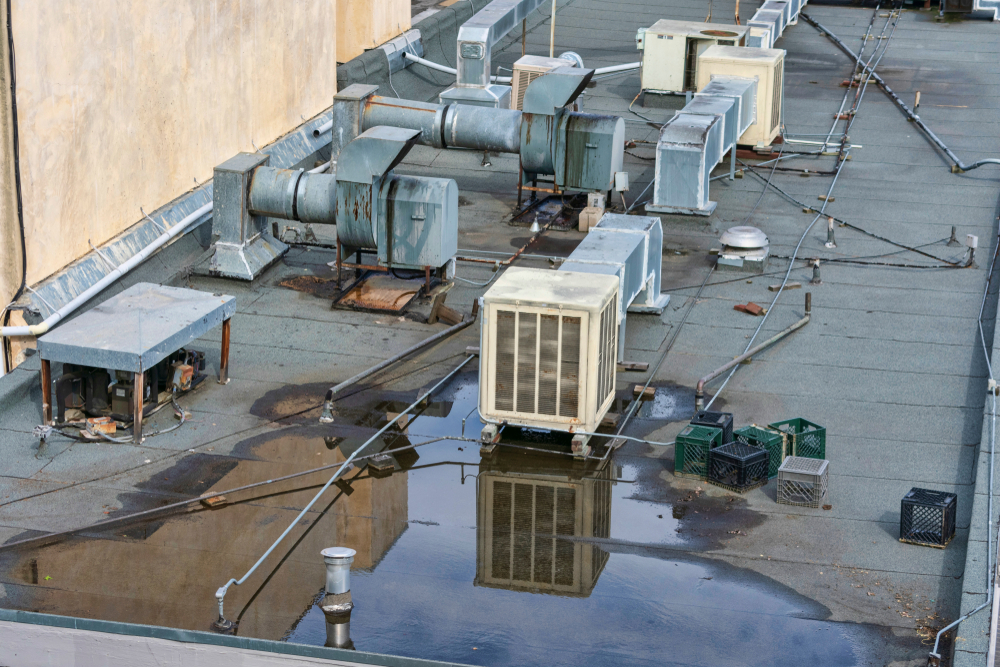A Guide to Commercial Roof Inspections
Author: Dan Stout | September 12, 2023
No one plans on having a roof failure. Yet every year, commercial roof leaks and collapses result in damage, injuries, and lawsuits.
The solution to this is simple: regularly scheduled commercial roof inspections.

For customers, such as property owners or managers, inspections are a safety feature that saves them from a potential disaster down the road. For roofers, inspections are a great way to build relationships and drum up business with potential or existing commercial customers.
How Often Should Inspections Occur?
The general guideline is that commercial roofs should be inspected twice a year. Inspections are typically done in the spring and fall, when it's easier to make repairs and to find damage away from the intense summer heat or winter rain or snow.
But it's also a good idea to schedule an inspection after extreme weather such as a tornado, hailstorm, or high winds. And commercial buildings may require more frequent inspections if they contain items particularly susceptible to water damage.
What Does a Commercial Roof Inspection Cover?
A commercial roof inspection thoroughly examines the interior, perimeter, and surface of the roof and provides suggestions for the customer's next steps.
The interior inspection should examine the following for signs of leaks:
- The underside of visible roof decking
- Interior insulation
- Interior walls and ceilings
The inspector will also walk the building perimeter, looking at items including:
- Fascia
- Gutters, downspouts, and drainage
- Potential hazards (tree limbs, signs, etc.)
On the roof itself, the inspection should include a wide variety of items and their conditions:
- Seams and flashing integrity
- Structural movement (expansion or contraction)
- Nail pops or loose fasteners
- Membrane weathering
- Ponding water
- Damage from wind or hail
- Rust on metal elements
- Moss or other growth
- Equipment (HVAC, solar panels), especially if installed since the last inspection
- Foot traffic damage
- Debris buildup
Some inspectors use a hole saw to take "core samples." This helps them see the structure of the roof and provide a detailed estimate for a replacement or extensive repairs. Core samples aren't usually needed during a maintenance inspection, especially when being conducted by the company that installed the roof, since they should have a record of what kind of roof was installed and when.
High-Tech Inspections
New technology allows more effective inspections than ever before.
Drones are a great option when parts of the roof are difficult or dangerous to reach. This is common when damage has made a roof unstable or when inspecting very steep slopes.
Thermal imaging cameras reveal moisture gathered at seams or beneath a membrane, hidden from the naked eye. They can also see areas that are losing heat, indicating damaged or insufficient insulation.
Risks of an Inspection Oversight
In addition to avoiding catastrophic roof failures, the kind that can occur if a roof is never inspected, skilled roof inspectors also catch small problems that can have an outsize financial impact.
For a customer, allowing a small leak to grow might result in damaged goods or a full roof replacement. For the roofer, it might mean a warranty call from an irate customer.
Additionally, some insurers require occasional inspections to confirm their customers are performing proper maintenance. And sometimes inspections are required to maintain the manufacturer's warranty. In these cases, cutting corners in an inspection (or skipping inspections completely) can cost much more than a quality inspection.
Knowledge Is Power
A detailed inspection report should not only explain the condition of the roof but also lay out the next steps for the customer.
There are essentially four types of actions recommended after a roof inspection.
1. Maintain
Continued maintenance is the baseline for a healthy roof. The next steps typically include removing any excess debris or moss, noting any areas of concern for future monitoring, and scheduling the next inspection.
2. Repair
Minor repairs should be presented to the customer along with an estimate, or simply be performed immediately if they fall within the scope of a maintenance agreement. This might include areas that need to be patched or small sections of flashing that need to be replaced.
3. Restore
Some roofs can be rejuvenated without a complete replacement. Depending on the type of roof and overall condition, a roof coating system may be the most economical solution.
4. Replace
Sometimes, a roof simply can't be salvaged. A replacement estimate may come with the inspection, or the customer may be put in touch with an estimator. Either way, it's important to make this process as seamless as possible.
Lessons Learned
When it comes to the cost/benefit analysis of a commercial roof inspection, here are the key points to bear in mind:
- Inspections are investments. Repairs fixed after early detection are far less expensive than fixing a leak and the items damaged as a result.
- Inspections can be bundled with a commercial maintenance plan, or be part of a warranty program.
- Inspections serve as a point of reference and can prove that specific damage is tied to a weather event.
- For clients, inspections are a shield, protecting them against high repair bills, voided warranties, and insurance headaches.
- It's better to inspect more often than needed than not enough.
Avoiding inspections can lead to costly repairs and property damage. Commercial roof inspections should be part of a yearly checklist for a property manager, and commercial roofers can use their existing relationships with customers to encourage them to get inspections.